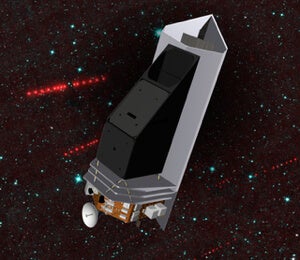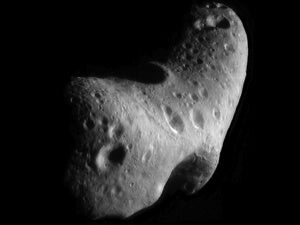Space and Technology Review: Asteroid Detection and Mining

Share
- [tweet_dis]Scientists have only catalogued 1% of near-Earth asteroids.[/tweet_dis]
- [tweet_dis]At the current pace, it would take 1,000 years to find all near-Earth asteroids.[/tweet_dis]
- [tweet_dis]New laws make asteroid mining potentially insanely lucrative.[/tweet_dis]
Millions of rocky objects orbit near Earth. Scientists have identified thousands of asteroids, but there are many that are still unaccounted for that could threaten regional or global disaster. Finding these asteroids may prevent a destructive impact—and may also prove a key resource to future space exploration.
This post explores our mission to find dangerous (and resource-rich) asteroids, and reviews the recent US law passed on asteroid mining that some speculate could result in a new trillion-dollar market for the space industry.
This is Part 3 of our Space GGC Series focused on important issues facing us now:
Part 1: Our Home Among the Stars
Part 2: The Race to the Moon and Mars
Part 3: Asteroid Detection and Mining
Part 4: Finding Extraterrestrial Life
The following information was curated from excerpts of previously published Singularity Hub articles on space exploration. Though this series isn't intended to be all-inclusive, we hope collecting a few key developments and insights in one place will deliver a broader view on the field. Special thanks to Jason Dorrier and Sarah Scoles for their works quoted here.

Arizona's mile-wide meteor crater was formed by a 45 meter impactor—the blast could have taken out an urban area the size of Kansas City.
“Asteroids are a real and potentially existential threat. But if we find them early enough, they’re fairly easy to deflect. With years or decades, instead of months or days, a small nudge is all you need to make them miss Earth.
Scientists have only cataloged about 10,000 or 1% of all near-Earth asteroids. It's estimated we've mapped about 90% of the biggest, extinction-level threats. But 10% are missing in action, and we know nothing of the million or so smaller but still immensely destructive asteroids that could take out an area the size of a state or city.
At the current pace, it would take a thousand years to find them all.
Asteroids are a real and potentially existential threat. But if we find them early enough, they’re fairly easy to deflect.
Part of the problem is that the telescopes on the ground or in Earth orbit have a limited view. And asteroids are the color of charcoal. The proverbial needle in a haystack—only the needle is black, the hay is black, and the stack is the size of the inner solar system.
There’s a relatively straightforward solution, however. Station a telescope near the orbit of Venus to expand its view, turn away from the glare of the sun, and look in the infrared, where the heat of an otherwise dark asteroid makes it easier to spot.
This is precisely the strategy behind B612's $450-million Sentinel telescope. The project is well underway and boasts a talented roster of deep space mission veterans. Ball Aerospace, the firm behind the Kepler Space Telescope and the optics in the James Webb Space Telescope (among other projects including Hubble), will build Sentinel.
Provided all goes to plan, Sentinel will launch on a SpaceX Falcon 9 rocket in 2018. The telescope will assume a Venus-like orbit and, looking back to Earth orbit, make repeated infrared observations of the sky in search of moving objects. The data will be sent to Earth, compiled in a public database, and used to calculate asteroid orbits.
According to B612, Sentinel could find over 20,000 new asteroids in its first month—more than all those found in the 30 years we’ve been looking. Over its 6.5-year mission (and it could be longer), the team believes they'll discover and catalog 90% of all asteroids bigger than 140 meters and many smaller asteroids down to 30 meters.”

NEOCam. Image credit: NASA/JPL-Caltech
“On September 29, 2015 NASA announced it was ending its connection to Sentinel.
NASA said that in light of the mission’s shortcomings, the agency needs the money for its own projects. And luckily for planetary safety—and knowledge of near-Earth objects (NEOs) in general, even if they aren’t civilization-crushers—those projects include NEO discovery and tracking. Such pursuits are, in fact, a law. In 2005, Congress mandated that NASA locate 90 percent of all near-Earth objects 140+ meters across by 2020.
With Sentinel not going quite as planned, and its promise remaining unfulfilled—perhaps not forever, but for its original timeline—what telescopes are tracking down and then continuing to track asteroids?
[In addition to NASA's ground-based asteroid-tracking telescopes], NEOCam is a proposed 50-centimeter-wide infrared telescope that would live in space, between Earth and the Sun, and would look for the heat signatures of asteroids. It aims to fulfill the congressional edict on 140-meter asteroids. It will work for four years and (hopefully) discover 67 percent of those large-ish asteroids, size them up, determine their chemistry, and map their rotation and orbits.
Be Part of the Future
Sign up to receive top stories about groundbreaking technologies and visionary thinkers from SingularityHub.


NEOCam hasn’t begun yet, but right around the time NASA announced they were defunding Sentinel, they announced that this mission had been selected as a finalist for the Discovery program, slated for potential launch by 2021. Over the next year, scientists will make more concrete plans for how it will work and how much it will cost. NEOCam would likely discover 10 times more NEOs than we know of now total.
The existing ground-based telescopes are great. We wouldn’t know of any asteroids at all without them (beyond the ones that actually hit Earth—telling us without a doubt about their existence). But to find the remaining asteroids, a space telescope is key. Sentinel may not make it, but the new NASA NEOCam could. And if both of them come to pass, we might climb over that 90 percent mark to get an A-grade on asteroid detection (and in protecting ourselves from future calamities).”
“On November 24, President Obama signed the “US Commercial Space Law Competitiveness Act” into law. Among other things (like that the government should not pester SpaceX), it states that any US citizen who takes a chip off an old block of asteroid then owns that chip.
The law also applies to other celestial bodies blessed with “resources,” like the Moon and every other planet and lower-case moon because “resources” is a vague word. The US citizen—or, more likely, a group of citizens who are part of a company, like Planetary Resources, Inc., or Deep Space Industries—can then “possess, own, transport, use, [or] sell” the resource.
The leaders of the two asteroid-mining frontrunners, who hope to extract things like precious metals and water from space rocks, spoke excitedly of the development.
And their joyousness makes sense: Without this law, they wouldn’t make money if they ventured to a space rock and mined its titanium. They wouldn’t own that metal, so they couldn’t sell it. Now they can. And that’s key if this new breed of space business is going to make it.
Both companies primarily plan to use their space resources to build more space stuff, like habitats for future astronauts, solar-power arrays, and rocket fuel. They hope to create a solar system in which they can sell the parts to make (or in the case of Deep Space Industries, ready-made) off-Earth hotels, orbital research stations, and deep-space rockets—from right in space. Some inside the industry speculate it’s a “trillion-dollar market.”
But whether that market will materialize—and whether it’s actually legal, even with this law—remains an open question.
The international Outer Space Treaty, made in 1967, prohibits any nation from claiming “sovereign territory” in space. And, when the president signed the bill, he clarified that a given asteroid can never be your asteroid—a piece of it can be your piece, if you remove that piece from the larger rock and if that piece counts as a “resource.”
In other words, you can’t own an asteroid: That would be illegal according to both the new and old laws—but you can own a valuable part of one, once it’s not part of the asteroid. It’s a little confusing (and perhaps outright contradictory). And the international community doesn’t necessarily see the law as fair: Right now, US citizens are the only people allowed to do the owning, while the previous agreement about space property ruled across the globe.”
That wraps up Space and Technology Review Part 3. Read Part 1 and Part 2, and stay tuned for Part 4.
Banner image credit: Shutterstock.com
Megan is director of Content Marketing for Singularity University. Before moving over to the Digital Media dark side, she was known as the marketing engine at SU. She brings the same strength and stamina to Singularity Hub to create engaging learning experiences.
Related Articles

How Scientists Are Growing Computers From Human Brain Cells—and Why They Want to Keep Doing It

Scientists Say We Need a Circular Space Economy to Avoid Trashing Orbit

Scientists Race to Deliver Custom Gene Therapies for Incurable Diseases in Weeks—Not Years
What we’re reading
